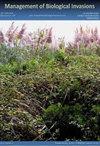Photosynthetic physiological and ecological responses of the invasive Sphagneticola trilobata and the native Sphagneticola calendulacea to experimental shading
IF 1.2
4区 环境科学与生态学
Q3 BIODIVERSITY CONSERVATION
引用次数: 1
Abstract
Affected by global climate change and human activities, biological invasion has become a serious global problem that not only occurs in cities and wastelands but also in forests, severely endangering biodiversity. Sphagneticola trilobata (L.) Pruski, 1996, is a common invasive plant in South China that can adapt to high light and high temperature environments, but its photosynthetic physiological response to shaded environments, such as forest margins, remains unclear. This study investigates the photosynthetic physiology and oxidative damage of S. trilobata and the native species Sphagneticola calendulacea (L.) Pruski, 1996, in a low-irradiance environment. The results show that, compared with the full-light group, photosynthetic gas exchange parameters (including net photosynthetic rate, stomatal conductance and transpiration rate) and chlorophyll fluorescence parameters (maximal quantum yield and actual quantum yield of PSII) of plants in the low-light group significantly decreased after shading, while intercellular CO 2 and nonphotochemical quenching increased; of note, S. trilobata experienced smaller changes. The malonaldehyde content of S. calendulacea increased, while phenols and the total antioxidant capacity of S. trilobata declined more significantly than those of the native species tested . These results further indicate that, compared with S. calendulacea , S. trilobata exhibited a lower loss in photosynthesis and less oxidative damage under shading. This may explain why S. trilobata tends to spread to forests in South China.入侵型三叶球藻和本土型金盏球藻对实验遮荫的光合生理生态响应
受全球气候变化和人类活动的影响,生物入侵已成为一个严重的全球性问题,不仅发生在城市和荒地,也发生在森林中,严重危及生物多样性。三叶藻(L.)Pruski, 1996,是华南地区常见的一种能适应强光高温环境的入侵植物,但其对林缘等荫凉环境的光合生理反应尚不清楚。研究了三叶虫和金盏花的光合生理和氧化损伤。Pruski, 1996,在低辐照度环境下。结果表明:与全光组相比,遮荫后弱光组植物的光合气体交换参数(包括净光合速率、气孔导度和蒸腾速率)和叶绿素荧光参数(PSII的最大量子产量和实际量子产量)显著降低,细胞间co2和非光化学猝灭增加;值得注意的是,三叶虫经历了较小的变化。金盏菊的丙二醛含量增加,而三叶草的酚类物质含量和总抗氧化能力的下降明显高于本地品种。这些结果进一步表明,与金盏菊相比,遮荫条件下三叶草的光合作用损失和氧化损伤更小。这也许可以解释为什么三叶虫倾向于传播到中国南方的森林。
本文章由计算机程序翻译,如有差异,请以英文原文为准。
求助全文
约1分钟内获得全文
求助全文
来源期刊

Management of Biological Invasions
Agricultural and Biological Sciences-Ecology, Evolution, Behavior and Systematics
CiteScore
3.40
自引率
6.70%
发文量
21
审稿时长
16 weeks
期刊介绍:
Management of Biological Invasions, established in 2010 by Dr. Elias Dana, is an open access, peer-reviewed international journal focusing on applied research in biological invasions in aquatic and terrestrial ecosystems from around the world. This journal is devoted to bridging the gap between scientific research and the use of science in decision-making, regulation and management in the area of invasive species introduction and biodiversity conservation.
Managing biological invasions is a crisis science, with Management of Biological Invasions aiming to provide insights to the issues, to document new forms of detection, measurements and analysis, and to document tangible solutions to this problem.
In addition to original research on applied issues, Management of Biological Invasions publishes technical reports on new management technologies of invasive species and also the proceedings of relevant international meetings. As a platform to encourage informed discussion on matters of national and international importance, we publish viewpoint papers that highlight emerging issues, showcase initiatives, and present opinions of leading researchers.
 求助内容:
求助内容: 应助结果提醒方式:
应助结果提醒方式:


